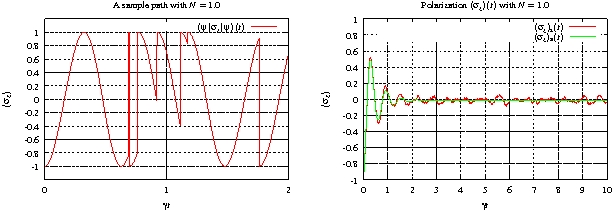With modern experimental techniques,
electric circuits are measurable in the physical circumstances, where
direct quantum mechanical phenomena are observable. The physical
understanding requires introduction of pure quantum concepts, principles
and laws. A concrete physical example is a Cooper-pair-box, which is a
superconducting island isolated from the larger superconducting loop by
two thin isolating layers. By connecting the island with an
inductor-capacitor oscillator (see figure below), quantum phenomena can
be observed at very low temperatures (T=30-40 mK). With a proper choice
of control and manufacturing parameters, the Cooper-pair-box forms an
effective quantum two-level system also know as a quantum bit or a
qubit. One of the elementary building blocks of the proposed quantum
computer is a register of qubits. 
Figure: A Cooper-pair-box (the section in between the
Josephson junctions denoted with crosses) coupled to the inductor
(L)-capacitor(C) oscillator and measured by recording the reflection of
the probe signal.
Quantum optics studies the interaction of light with matter at the elementary level. In electric circuit analogues, the LC-oscillator models the monochromatic photon field and the atom is build from the Cooper-pair-box in which discrete energy levels are formed analogous to real atoms and molecules. The main advantage of the new approach is that it pushes the traditional quantum optics in unexplored parameter and phenomena realms, an example is shown in Ref. [1]. My research attention is focused on methods to solve time-dependent quantum mechanical problems, specially using quantum trajectories or Floquet method.
Quantum trajectories
The master equation models the dynamics of open quantum systems and
is thus one of the fundamental conceptual tools in quantum optics. On
the one hand, quantum trajectory approach is only an efficient
computational method to solve the master equation, but on the other hand
it opens an alternative point of view to quantum dynamics. Quantum
trajectory follows the time-development of a single measurement run
instead of averages or expectation values (see, for example, Refs. [2]
and [3] for more details about quantum trajectories in circuit QED). I
have applied the quantum trajectory simulation procedure to study the
motional averaging phenomena [4, 5] in superconducting electric
circuits. 
Figure: Quantum trajectories for a driven qubit embedded in environment with non-zero temperature; (left) A quantum trajectory showing abrupt quantum jumps in the polarization of the qubit; (right) The polarization of the qubit averaged over 1000 trajectories (red) compared with the analytical solution (green).
Floquet method
In general, time-dependent quantum mechanical problems are hard or
impossible to solve analytically, i.e. without resorting to various
numerical methods. If the system turns up to be periodic in time, one
can use the so-called Floquet method [6] to solve the time-dependent
problem like it were time-independent. By using the Floquet method all
the results and methods developed in time-independent quantum mechanics
are applicable to time-periodic problems. As an application, we have
shown that a strongly driven and weakly probed qubit can be analyzed and
understood very accurately by using Fermi's golden rule in the Floquet
space [7, 8]. 
Figure: Application of the Floquet method to a strongly
driven and weakly probed qubit [6]: (left) The quasienergy landscape;
(centre) The energy flow from resonator to qubit calculated by using
Fermi's golden in the Floquet space; (right) The measured reflection
coefficient.
References
[1] L. V. Bishop, J. M. Chow, J. Koch, A. A. Houck, M. H. Devoret, E. Thuneberg, S. M. Girvin, R. J. Schoelkopf, Nonlinear response of the vacuum Rabi resonance, Nature Physics 5, 105 (2009).
[2] J. Gambetta, A. Blais, M. Boissonneault, A. A. Houck, D. I. Schuster, S. M. Girvin, Quantum trajectory approach to circuit QED: Quantum jumps and the Zeno effect, Physical Review A 77, 012112 (2008).
[3] R. Vijay, D. H. Slichter, I. Siddiqi, Observation of quantum jumps in a superconducting artificial atom, Physical Review Letters 106, 110502 (2011).
[4] M. Silveri, M. Sc. Thesis, Motional averaging in a qubit and a harmonic oscillator, University of Oulu, 2009.
[5] Jian Li, M. P. Silveri, K. S. Kumar, J.-M. Pirkkalainen, A. Vepsäläinen, W. C. Chien, J. Tuorila, M. A. Sillanpää, P. J. Hakonen, E. Thuneberg, and G. S. Paraoanu, Motional averaging in a superconducting qubit, Nature Communications 4, 1420 (2013).
[6] J. H. Shirley, Solution of the Schrödinger equation with a Hamiltonian periodic in time, Physical Review 138, B 979 (1965).
[7] J. Tuorila, M. Silveri, M. Sillanpää, Y. Makhlin, E. Thuneberg and P. Hakonen, Stark effect and generalized Bloch-Siegert shift in a strongly driven two-level system, Physical Review Letters 105, 257003 (2010).
[8] Matti Silveri, Jani Tuorila, Mika Kemppainen, and Erkki Thuneberg, Probe spectroscopy of quasienergy states, Physical Review B 87, 134505 (2013).